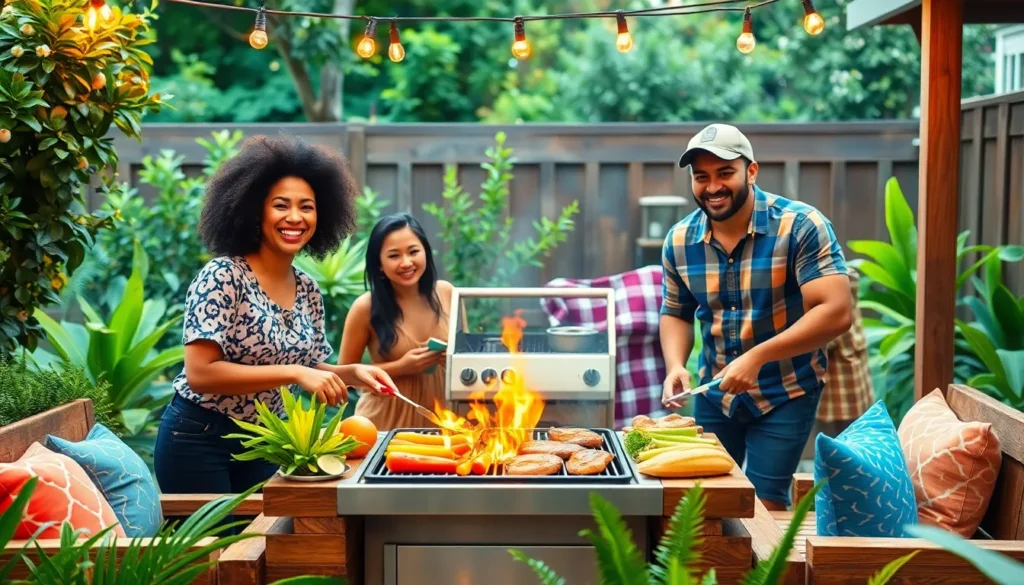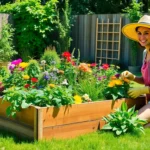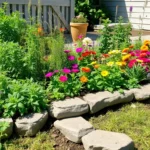Nothing beats the satisfaction of hosting an unforgettable backyard barbecue that brings family and friends together around delicious food and great memories. We’re here to transform your garden into the ultimate BBQ destination with creative ideas that’ll make your outdoor space the neighborhood’s go-to gathering spot.
Whether you’re working with a sprawling lawn or a cozy patio, we’ve discovered countless ways to elevate your grilling game beyond basic burgers and hot dogs. From clever cooking techniques that’ll impress your guests to smart setup strategies that maximize your outdoor space, these BBQ ideas will revolutionize how you think about garden entertaining.
We’ll explore everything from innovative menu planning and creative serving answers to essential equipment upgrades and atmospheric touches that turn any ordinary cookout into an extraordinary experience. Get ready to become the BBQ host everyone talks about long after the last ember fades.
Choose the Perfect BBQ Setup for Your Garden Space
Your garden’s size and layout determine which BBQ setup will work best for creating memorable outdoor dining experiences. We’ll explore three main categories that cater to different space requirements and commitment levels.
Portable Grill Options for Small Gardens
Compact charcoal grills offer authentic smoky flavors while fitting into tight spaces like patios, balconies, or small backyards. Weber’s 14-inch Smokey Joe weighs just 9.5 pounds and provides 147 square inches of cooking space, perfect for grilling burgers, chicken, or vegetables for 2-4 people.
Electric grills eliminate the need for propane tanks or charcoal storage, making them ideal for apartment dwellers or those with limited outdoor space. George Foreman’s indoor/outdoor electric grill reaches temperatures up to 400°F and plugs into any standard outlet, delivering consistent heat without smoke concerns.
Tabletop gas grills combine portability with powerful cooking performance through compact designs that sit on existing outdoor furniture. Coleman’s RoadTrip series features adjustable legs, folding side tables, and 285 square inches of cooking area while weighing only 47 pounds for easy transport and storage.
Built-In BBQ Stations for Permanent Installations
Masonry BBQ islands create impressive focal points that increase property value while providing extensive cooking and prep space. These permanent structures typically include a gas grill, side burners, storage cabinets, and countertop areas measuring 6-10 feet in length with materials like natural stone, brick, or stucco finishes.
Modular outdoor kitchen systems allow customization through interlocking components that accommodate different garden layouts and budgets. Brands like Bull Outdoor Products offer pre-fabricated sections including grill heads, refrigeration units, ice makers, and storage modules that create professional-grade cooking stations.
Custom concrete installations provide unlimited design flexibility for unique garden spaces through poured concrete foundations topped with tile, granite, or other weather-resistant surfaces. These setups often incorporate features like pizza ovens, rotisseries, and warming drawers that transform outdoor cooking into restaurant-quality experiences.
Smoker Answers for Authentic Flavors
Offset barrel smokers produce traditional BBQ flavors through separate fireboxes that generate smoke and indirect heat for low-and-slow cooking methods. Oklahoma Joe’s Highland model offers 619 square inches of cooking space with temperature gauges and adjustable dampers for precise heat control during 8-12 hour smoking sessions.
Kamado ceramic grills combine smoking, grilling, and baking capabilities in egg-shaped designs that retain moisture and distribute heat evenly. Big Green Egg’s Large model reaches temperatures from 200°F to 750°F while using less charcoal than traditional smokers, making it perfect for everything from brisket to pizza.
Electric pellet smokers automate the smoking process through digital controls that maintain consistent temperatures while feeding compressed wood pellets into fireboxes. Traeger’s Pro Series features WiFi connectivity, allowing remote monitoring and temperature adjustments through smartphone apps during extended cooking times.
Create Comfortable Seating Areas Around Your BBQ Zone
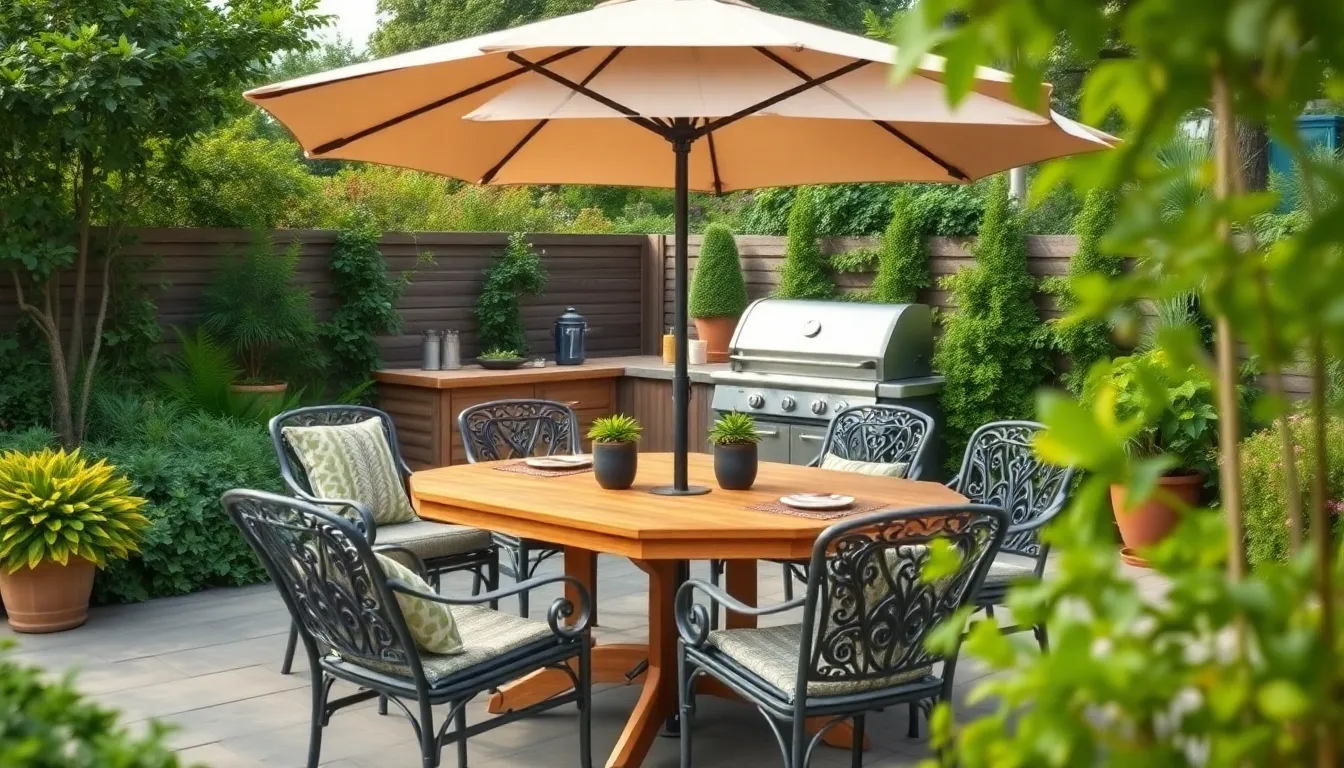
Creating the perfect seating arrangement transforms your BBQ zone into a welcoming gathering space where guests naturally want to linger. We’ll help you design comfortable areas that enhance both safety and social interaction around your outdoor cooking space.
Outdoor Dining Sets That Complement Garden Aesthetics
Teak wood dining sets offer the perfect combination of durability and natural beauty for your garden BBQ area. This premium material naturally resists weather damage while developing an attractive patina over time that blends seamlessly with garden surroundings.
Simple, elegant designs work best when selecting outdoor dining furniture that won’t compete with your garden’s natural beauty. Clean lines and understated styling allow the focus to remain on the food and conversation rather than overwhelming decorative elements.
Strategic placement of your dining area requires adequate lighting and generous space allocation for comfortable movement. Position tables where guests can easily access both the BBQ station and indoor facilities without creating traffic bottlenecks.
Fire-Safe Seating Materials and Arrangements
Cast aluminum furniture provides superior fire resistance compared to wicker or hardwood options while maintaining style and comfort. This durable material withstands high temperatures and won’t ignite if sparks fly from your grill area.
Fire-resistant cushion materials like treated polyester and fire-resistant vinyl ensure guest safety without sacrificing comfort. These specialized fabrics resist ignition and provide peace of mind during active grilling sessions.
Proper spacing between seating and heat sources prevents accidents while maintaining social connectivity. Arrange chairs and benches at least 8 feet away from direct flames while keeping conversation distances comfortable.
Shade Answers for All-Day Comfort
Large umbrellas and canopies provide flexible shade options that adapt to changing sun positions throughout your BBQ event. These portable answers offer immediate relief from harsh sunlight and can be repositioned as needed.
Gazebos create permanent shade structures that define your outdoor dining space while offering weather protection. Strategic placement of these covered areas ensures guests have comfortable retreat options during peak sun hours.
Natural tree coverage provides the most sustainable shade solution for BBQ areas exposed to direct sunlight. Planting fast-growing shade trees around your outdoor cooking zone creates cool microclimates that improve comfort for years to come.
Design Functional Food Prep and Storage Stations
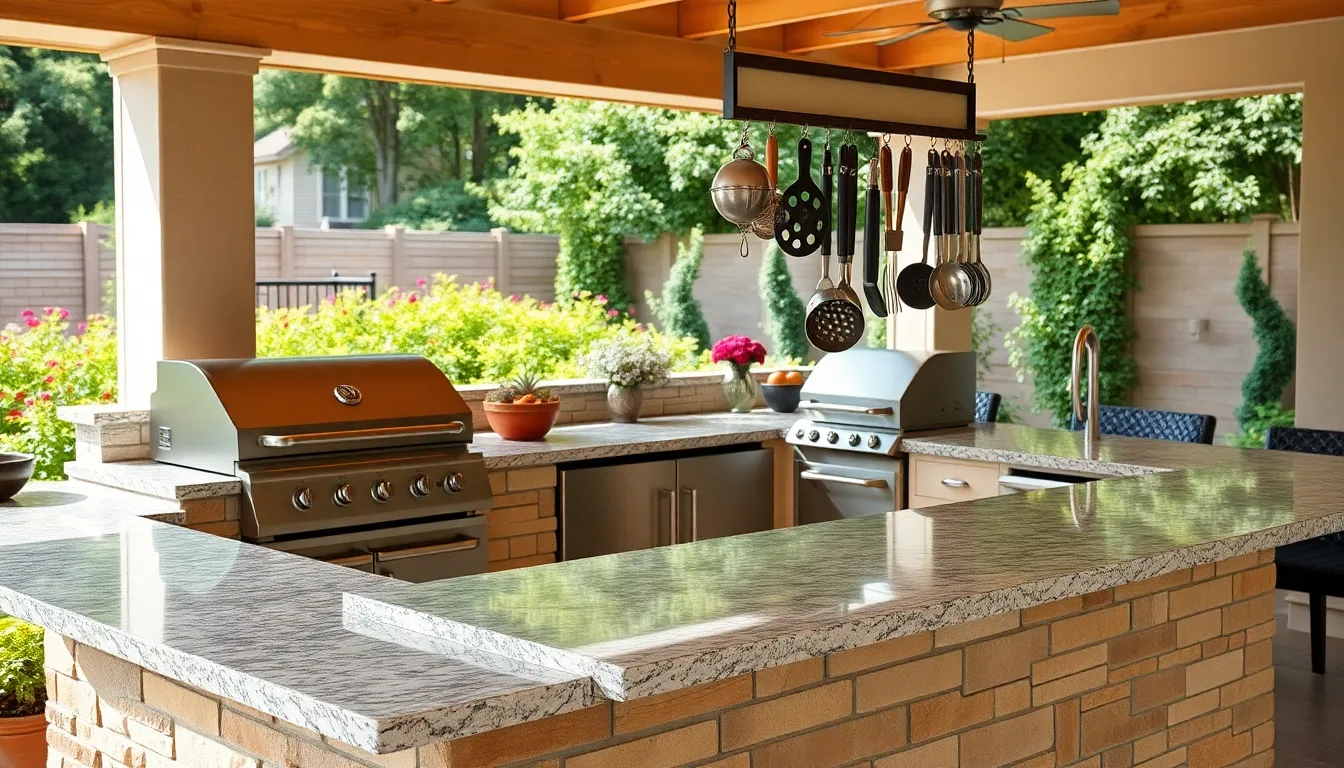
Creating efficient prep and storage stations transforms your garden BBQ experience from chaotic cooking to seamless entertaining. We’ll help you design functional spaces that keep everything organized and within reach.
Weather-Resistant Prep Tables and Countertops
Stainless steel surfaces offer the ultimate durability for outdoor food preparation, resisting both heat and moisture damage that can destroy ordinary materials. These commercial-grade surfaces maintain their appearance through countless BBQ sessions and require minimal maintenance to stay pristine.
Granite countertops provide exceptional heat resistance while adding elegant style to your outdoor kitchen setup. We recommend these natural stone surfaces because they withstand temperature fluctuations and create stunning focal points that increase property value.
Smooth finish surfaces help effortless cleanup and prevent bacterial growth that can compromise food safety. Easy maintenance becomes crucial when you’re hosting frequent gatherings and need quick turnaround between events.
Modular prep stations adapt to changing needs and can be reconfigured based on your menu requirements. These flexible units allow you to customize your workspace for different types of cooking projects throughout the season.
Smart Storage Answers for BBQ Tools and Supplies
Built-in cabinets maximize storage efficiency by utilizing space under countertops and alongside grilling areas. We suggest incorporating drawers with dividers to organize utensils, seasonings, and frequently used tools for quick access during cooking.
Hanging rack systems keep essential tools visible and within arm’s reach while freeing up valuable prep space. Strategic placement of these racks near your primary cooking zone reduces movement and increases efficiency during busy grilling sessions.
Weatherproof storage containers protect expensive BBQ supplies from moisture and temperature extremes that can damage equipment. Invest in sealed units that maintain consistent internal conditions regardless of outdoor weather changes.
Tool-exact organizers create designated spots for spatulas, tongs, thermometers, and cleaning supplies. This systematic approach prevents lost items and ensures you’ll always find what you need when flames are hot and timing matters.
Outdoor Refrigeration and Cooling Options
Outdoor refrigerators maintain consistent temperatures while withstanding harsh weather conditions that would destroy indoor units. These specialized appliances feature enhanced insulation and weatherproof seals designed specifically for outdoor installation.
Large capacity coolers serve as portable alternatives for keeping beverages and perishable items properly chilled throughout extended gatherings. We recommend wheeled models that can be easily repositioned based on your serving needs and guest flow patterns.
Ice bucket stations provide convenient drink cooling without requiring electrical connections or permanent installation. Strategic placement of these vessels near seating areas encourages guests to serve themselves and reduces your hosting workload.
Beverage refrigeration units offer dedicated cooling space for drinks while freeing up main refrigerator capacity for food storage. These compact appliances integrate seamlessly into outdoor kitchen designs and provide easy access for both hosts and guests.
Plan Garden-to-Grill Menu Ideas Using Fresh Herbs and Vegetables
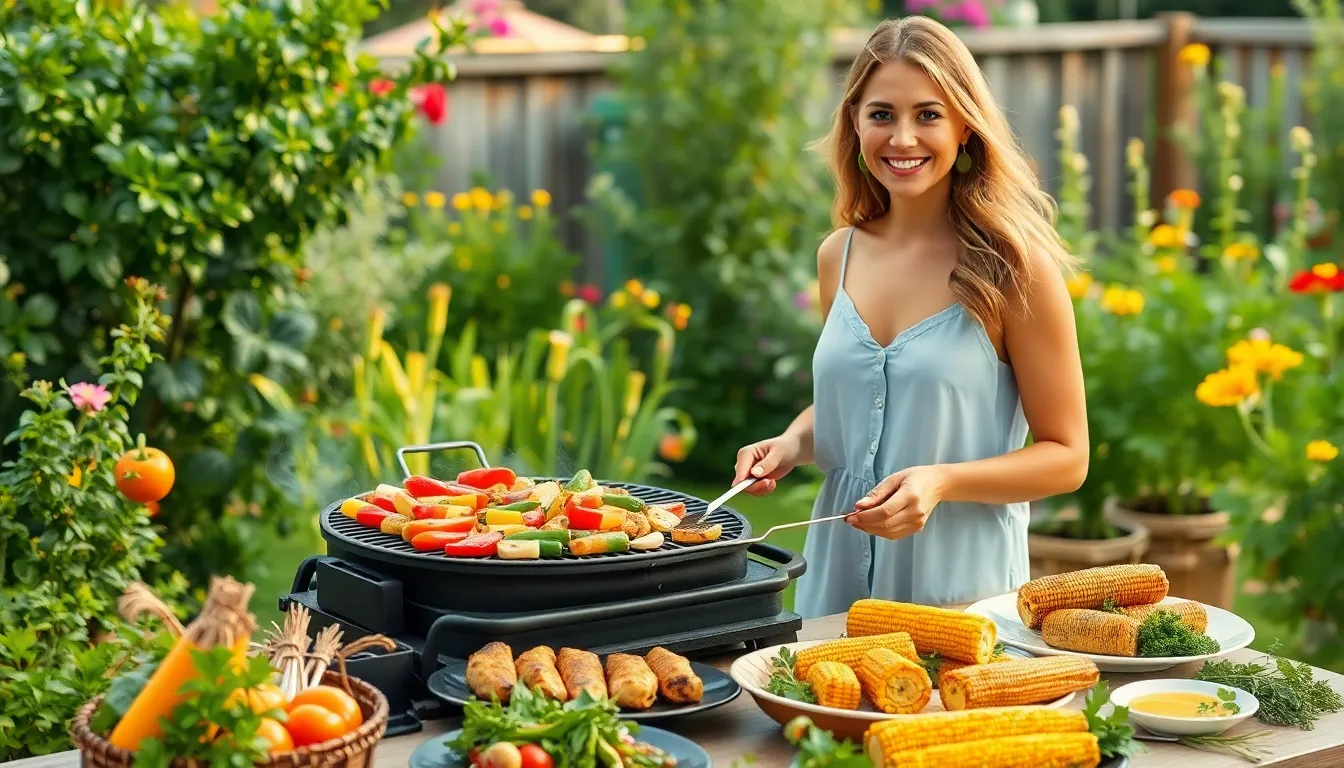
Planning your BBQ menu around fresh garden produce elevates your outdoor cooking experience while showcasing your harvest at its peak flavor.
Grilled Vegetable Combinations from Your Garden
Peppers and onions create versatile grilled combinations that enhance any BBQ spread. Slice these vegetables thinly and grill them in a basket for perfect toppings on steaks, pizzas, or sausage sandwiches.
Fresh corn delivers sweet smoky flavors when grilled “naked” on direct heat. Season ears with olive oil, kosher salt, and pepper, then baste with herb butter for restaurant quality results.
Carrots and beets transform into gourmet sides through smoke roasting techniques. Prepare carrots with sage brown butter, while beets shine in a smoked beet salad with smoky raisin vinaigrette.
Broccoli, bell peppers, and carrots combine beautifully for vegan friendly grilled platters. Toss these colorful vegetables with fresh herbs and olive oil for maximum flavor absorption.
Zucchini, mushrooms, and eggplant form hearty vegetable combinations perfect for main course presentations. Arrange these garden favorites on large platters for impressive visual appeal.
Herb-Infused Marinades and Rubs
Lemon, olive oil, and white wine create the foundation for Mediterranean inspired marinades. Mix fresh herbs from your garden into this base for vegetables that burst with bright flavors.
Garlic and mint combinations offer refreshing alternatives to traditional BBQ seasonings. Blend lemon juice with garlic and fresh mint for marinades that complement grilled vegetables perfectly.
Sage brown butter transforms simple vegetables into sophisticated sides. Brush this aromatic mixture onto root vegetables during the final minutes of grilling.
Fresh herb rubs maximize the flavor potential of garden vegetables. Combine chopped herbs with olive oil and seasonings for dry rubs that create beautiful caramelized surfaces.
Farm-to-Table BBQ Recipes
Grilled potato salad reimagines the classic side dish with smoky char flavors. Top warm grilled potatoes with fresh herbs and green onions for a modern twist on tradition.
Bacon wrapped jalapeño poppers showcase garden peppers in crowd pleasing appetizers. Stuff fresh jalapeños with crab filling and wrap in bacon for irresistible finger foods.
Smoked beet salad elevates humble garden beets into restaurant worthy dishes. Combine smoked beets with smoky raisin vinaigrette for complex flavor profiles.
Herb butter basted corn transforms simple ears into gourmet sides. Create compound butters using garden herbs like rosemary, thyme, or basil for unique flavor combinations.
Install Proper Lighting for Evening BBQ Sessions
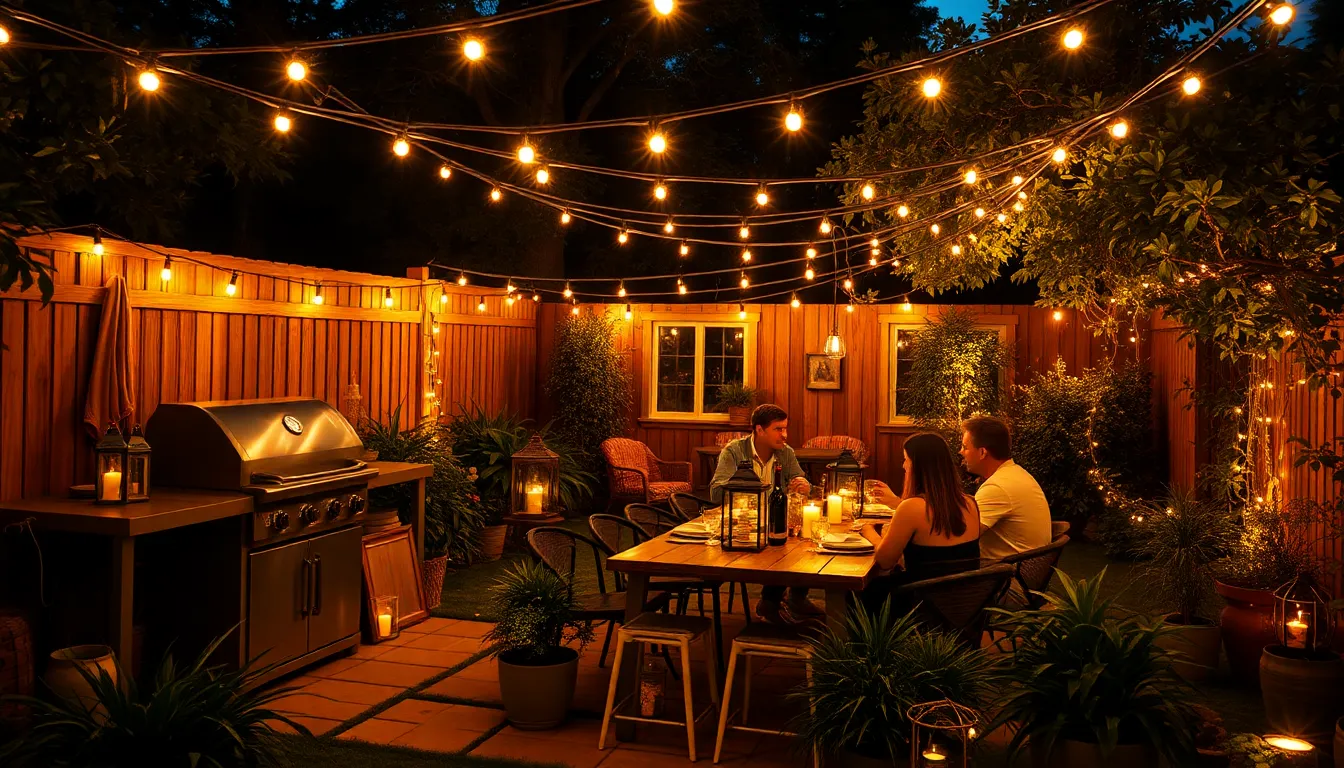
Evening BBQ sessions require strategic lighting to maintain both safety and ambiance for our guests. We can transform our garden BBQ space with the right combination of functional and decorative lighting answers.
String Lights and Ambient Garden Lighting
String lights create the perfect foundation for evening BBQ ambiance. We recommend outlining the perimeter of our BBQ or dining area with warm LED string lights to provide soft, inviting illumination. This approach fosters a cozy atmosphere that encourages guests to linger and socialize throughout the evening.
LED candles and small lanterns complement string lights beautifully. Placing these decorative elements at our dining table adds charm and creates intimate conversation areas. We can mix different heights and styles of lanterns to create visual interest while maintaining consistent warm lighting.
Ambient lighting extends beyond the immediate BBQ zone. Garden bed lighting and pathway illumination help define our outdoor space while ensuring guests can navigate safely between different areas of our garden BBQ setup.
Task Lighting for Safe Food Preparation
Dedicated grill lighting ensures accurate cooking after dark. We should install gooseneck fixtures mounted directly above our grill to illuminate the cooking surface clearly. This focused lighting improves both safety and cooking precision during evening BBQ sessions.
Prep area lighting enhances food safety and efficiency. Under counter strip lights provide focused illumination for chopping, plating, and other food preparation tasks. We can install these fixtures beneath our prep station countertops to reduce shadows and prevent accidents.
Wall sconces over entryways and counters add both function and style. These fixtures enhance visibility in key areas while contributing to our garden’s overall aesthetic appeal. Outdoor gooseneck lights work particularly well for this application.
Solar-Powered Lighting Answers
Solar powered lights offer eco friendly illumination without additional wiring. These fixtures automatically charge during daylight hours and activate at dusk, providing convenient pathway and garden bed lighting. We can place them strategically around seating areas and walkways without worrying about electricity costs.
Wireless installation makes solar lights incredibly versatile. We can easily relocate these fixtures as our garden BBQ layout evolves or seasonal needs change. This flexibility allows us to experiment with different lighting arrangements until we find the perfect configuration.
Automatic operation eliminates the need for manual switching. Solar lights turn on and off based on natural light levels, ensuring our garden BBQ space is always properly illuminated when guests arrive for evening gatherings.
Incorporate Natural Landscaping Around Your BBQ Area
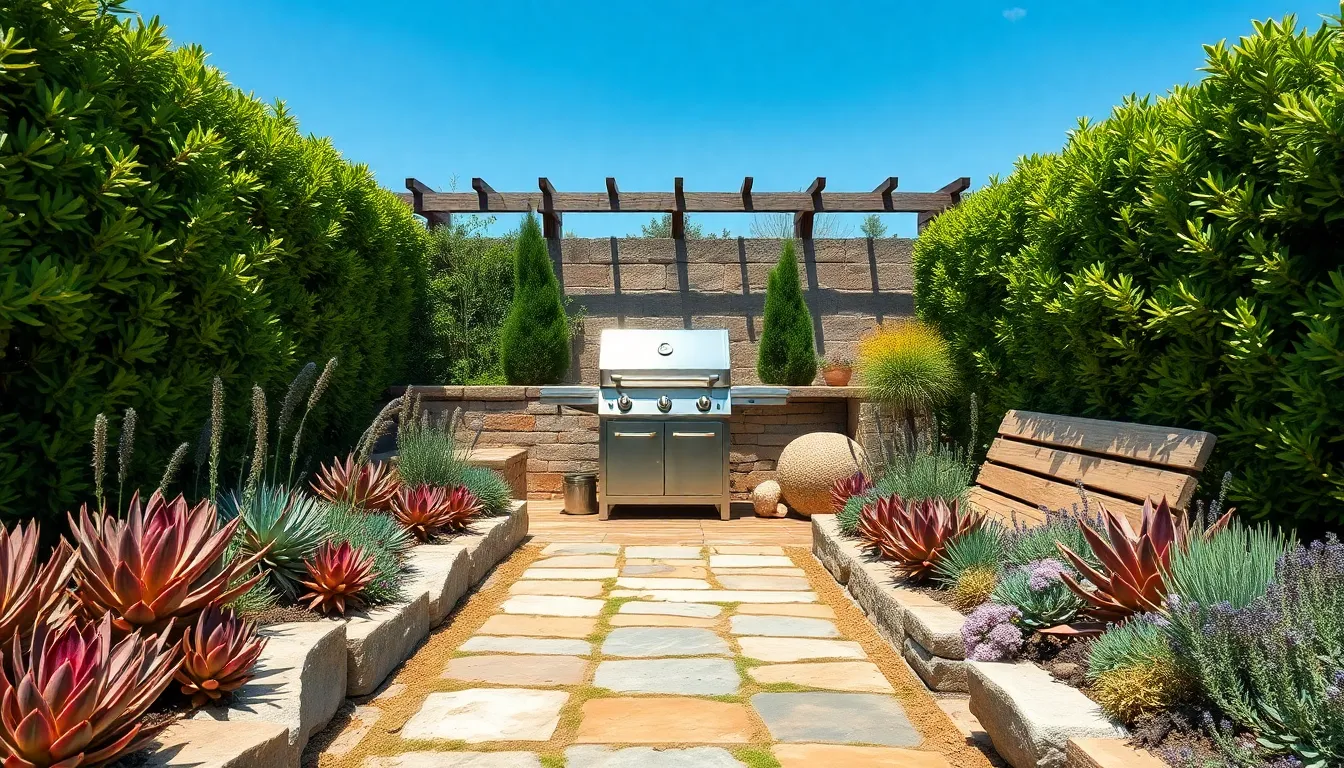
Natural landscaping transforms your BBQ space into a cohesive outdoor living environment that seamlessly blends cooking functionality with garden beauty. Strategic plant placement and hardscaping elements create an inviting atmosphere while maintaining practical considerations for grilling safety.
Heat-Resistant Plants That Thrive Near Grills
Succulents offer the perfect solution for areas directly adjacent to your grill station. These plants with thick, fleshy leaves naturally withstand high temperatures and require minimal maintenance, making them ideal companions for busy BBQ hosts. Sedum varieties create attractive ground coverage while tolerating both heat exposure and occasional drought conditions.
Drought-tolerant plants like yucca provide architectural interest without compromising safety around cooking areas. We recommend positioning these hardy specimens at least three feet from active grilling zones to ensure they receive enough protection while still benefiting the overall industry design. Agave plants also thrive in these challenging conditions, adding sculptural elements to your outdoor cooking space.
Mediterranean herbs such as rosemary and lavender serve dual purposes in BBQ landscaping. These aromatic plants release pleasant fragrances when warmed by grill heat while providing fresh ingredients for your cooking adventures. Their natural heat tolerance makes them perfect border plants around patio edges.
Privacy Screening with Garden Elements
Hedges create natural boundaries that shield your BBQ activities from neighboring properties. Boxwood and privet species grow densely enough to provide effective screening while maintaining neat, manageable appearances throughout the growing season. These traditional hedge plants respond well to regular trimming, allowing you to maintain desired heights and shapes.
Bamboo screens offer eco-friendly privacy answers that establish quickly in most garden conditions. We suggest selecting clumping bamboo varieties rather than running types to prevent unwanted spreading throughout your industry. These fast-growing plants create effective barriers within a single growing season.
Climbing vines trained on trellises or pergolas add vertical privacy elements while maximizing ground space usage. Clematis and wisteria create beautiful flowering screens that provide seasonal interest beyond simple privacy functions. Position these structures to block sightlines from exact angles while maintaining airflow around your cooking area.
Pathways and Hardscaping Integration
Stone pathways create durable connections between your garden areas and BBQ station using materials like flagstone or bluestone. These natural materials withstand heavy foot traffic while complementing existing industry features. We recommend installing pathway lighting along these routes for safe evening navigation during extended BBQ sessions.
Brick walkways offer classic appeal that works well with both traditional and contemporary garden designs. Clay brick pavers provide excellent traction even when wet, making them practical choices for areas that might encounter cooking spills or cleaning water. These materials age gracefully, developing attractive patinas over time.
Gravel paths deliver cost-effective answers that drain well and require minimal maintenance compared to solid paving options. Crushed granite or pea gravel creates attractive walking surfaces that define circulation routes without overwhelming garden plantings. Strategic placement of stepping stones within gravel areas adds visual interest while providing stable footing.
Hardscaping elements like stone walls and decorative pavers define distinct activity zones within your outdoor space. These permanent features create natural separations between cooking, dining, and garden areas while adding structural visual interest to the overall design. Incorporating matching materials throughout different hardscaping elements creates cohesive design themes that tie your entire outdoor space together.
Add Weather Protection and Seasonal Extensions
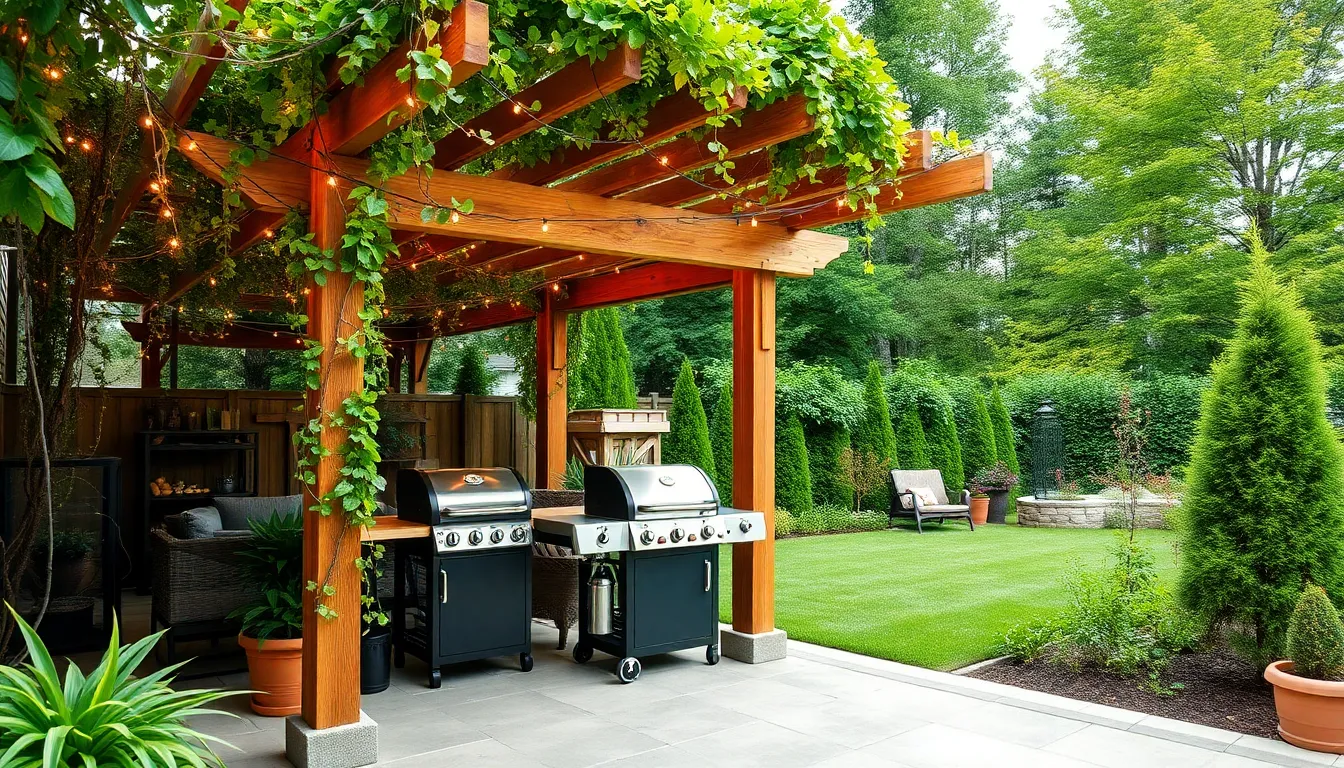
Extending your BBQ season beyond perfect weather days maximizes your outdoor cooking investment. Smart weather protection lets us enjoy grilling year-round while keeping our guests comfortable.
Pergolas and Gazebos for Covered Cooking
Pergolas create stylish overhead coverage that transforms exposed grilling areas into comfortable cooking zones. We can adorn these wood-based structures with climbing plants or string lights to enhance the ambiance while providing partial shade from sun and light rain.
Gazebos offer complete weather protection with full roof coverage that shields both the grill and cook from harsh elements. These structures work particularly well for full-scale outdoor kitchens where we need consistent coverage for multiple cooking stations and prep areas.
Cedar and redwood pergolas naturally resist weather damage while maintaining their attractive appearance throughout multiple seasons. We recommend positioning these structures to allow proper ventilation around gas and charcoal grills while maintaining adequate clearance from flames.
Windbreaks and Privacy Screens
Natural hedges provide dual-purpose protection by blocking strong winds and creating privacy around our BBQ areas. These living windbreaks also integrate seamlessly with our garden’s existing landscaping design.
Portable screens offer flexible wind protection that we can adjust based on changing weather conditions and guest arrangements. We position these barriers strategically to redirect airflow without completely blocking natural ventilation around the cooking area.
Privacy screens enhance intimate dining experiences by creating secluded spaces within larger gardens. We install these elements using materials that complement our existing hardscaping and pergola designs for visual continuity.
Winterizing Your Outdoor BBQ Setup
Portable wheel-based barbecues allow easy relocation to protected storage areas during harsh winter months. We move these units to sheds or garages where they’re shielded from snow, ice, and extreme temperature fluctuations.
Built-in barbecue stations require weatherproof covers specifically designed for their dimensions and configuration. We invest in heavy-duty covers that protect cooking surfaces, control panels, and storage compartments from moisture damage.
Tabletop barbecues need complete indoor storage during winter seasons to prevent component deterioration. We clean these compact units thoroughly before storing them in climate-controlled spaces where they’ll remain ready for spring cooking sessions.
Ensure Safety and Compliance in Your Garden BBQ Design
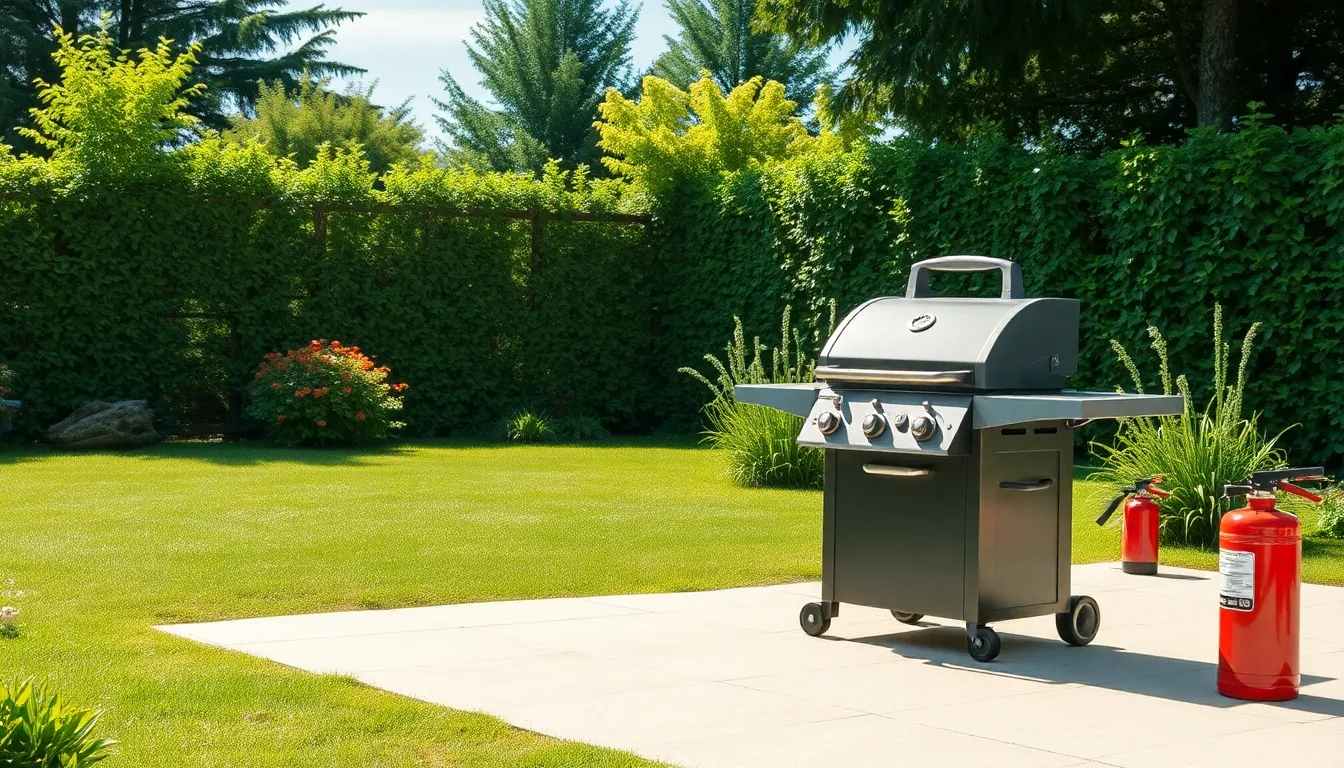
Before we fire up our grills and start hosting memorable gatherings, we need to prioritize safety measures and compliance standards for our garden BBQ setup.
Fire Safety Measures and Clearance Requirements
Position your grill on a flat, sturdy surface away from your house and any combustible materials to prevent dangerous fire hazards. We recommend maintaining a safe zone around the entire grilling area, keeping it completely free from flammable materials, children, and pets during cooking sessions.
Create adequate clearance from overhanging structures like trees, gazebos, or pergolas to eliminate potential fire risks in your garden BBQ space. Most manufacturers specify minimum distance requirements, typically ranging from 3 to 10 feet depending on your grill type and local conditions.
Store propane tanks in upright positions away from heat sources, and regularly inspect gas connections for leaks using soapy water answers. We suggest keeping a fire extinguisher rated for grease fires within easy reach of your cooking area at all times.
Ventilation Considerations for Enclosed Spaces
Install an exhaust hood when grilling in enclosed or partially covered areas to manage smoke effectively and prevent it from entering your home. Proper ventilation systems help maintain air quality while allowing you to enjoy extended cooking sessions regardless of weather conditions.
Design your covered BBQ area with adequate airflow by incorporating open sides or strategic ventilation gaps that allow smoke to escape naturally. We recommend consulting with ventilation specialists for complex outdoor kitchen installations to ensure optimal air circulation.
Position your grill where prevailing winds can help carry smoke away from seating areas and neighboring properties, creating a more comfortable environment for all guests.
Local Building Codes and Permit Requirements
Check local building codes about outdoor kitchen installations, though exact requirements for BBQ grills are typically minimal beyond manufacturer instructions and basic clearance guidelines. We always recommend verifying current regulations with your local building department before beginning any permanent installations.
Consult local authorities for necessary permits before constructing or installing permanent outdoor kitchen structures, as requirements vary significantly between municipalities and property types. Some areas require permits for gas line installations, electrical work, or structures exceeding certain size thresholds.
Document your BBQ installation process with photos and receipts, as this information may be required for insurance claims or future property transactions involving your outdoor cooking area.
Conclusion
We’ve covered everything you need to transform your garden into the ultimate BBQ destination. From choosing the right equipment to creating comfortable gathering spaces these ideas will help you host memorable outdoor cooking experiences.
The key to successful garden BBQ entertaining lies in thoughtful planning and smart design choices. By incorporating proper lighting landscaping and safety measures you’ll create an outdoor kitchen that works beautifully year-round.
Remember that the best BBQ setups blend functionality with style while keeping your guests comfortable and engaged. Start with one or two key improvements and gradually build your perfect outdoor cooking space. Your garden has the potential to become everyone’s favorite gathering spot.
Frequently Asked Questions
What type of BBQ setup is best for small gardens?
For small gardens, portable options work best. Compact charcoal grills offer authentic smoky flavors, electric grills provide convenience for quick cooking, and tabletop gas grills deliver reliable performance without taking up much space. These options are easy to store and move around as needed.
How far should my grill be placed from my house for safety?
Your grill should be positioned at least 10 feet away from your house, deck railings, and any overhanging structures. This clearance prevents fire hazards and ensures proper ventilation. Also keep grills away from low-hanging branches and combustible materials like outdoor furniture.
What are the best weather-resistant materials for outdoor BBQ stations?
Stainless steel and granite are top choices for countertops due to their durability and easy maintenance. For seating, cast aluminum withstands weather well, while teak wood naturally resists moisture. Choose fire-resistant cushions and covers that can handle outdoor elements year-round.
Which plants work best around BBQ areas?
Heat-resistant plants like succulents, yucca, and agave thrive near grills while maintaining safety. Mediterranean herbs such as rosemary, thyme, and lavender provide fragrance and fresh cooking ingredients. Avoid placing flammable plants too close to cooking areas for safety reasons.
How can I keep my BBQ area comfortable during hot weather?
Install shade solutions like large umbrellas, gazebos, or pergolas to protect guests from direct sunlight. Position seating areas strategically to take advantage of natural tree coverage. Consider portable misters or fans for additional cooling during peak summer temperatures.
What lighting do I need for evening BBQ sessions?
Combine ambient lighting like string lights for atmosphere with task lighting over grills and prep areas for safety. LED candles and lanterns create intimate conversation spaces. Solar-powered options provide eco-friendly illumination that automatically activates at dusk without requiring electrical connections.
Do I need permits for permanent BBQ installations?
Most permanent BBQ installations require building permits and must comply with local fire codes. Check with your local building department before installing built-in stations, gas lines, or electrical connections. Requirements vary by location and installation complexity, so research beforehand.
How do I winterize my outdoor BBQ setup?
Store portable grills indoors during harsh weather to prevent rust and damage. Cover built-in stations with heavy-duty weatherproof covers. Disconnect and store gas tanks safely. Clean all equipment thoroughly before storage and perform maintenance checks when bringing them back out.

